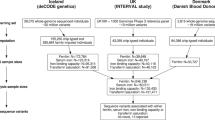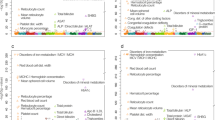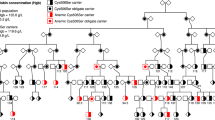Abstract
We undertook a quantitative trait locus (QTL) analysis in mice to identify modifier genes that might influence the severity of human iron disorders. We identified a strong QTL on mouse chromosome 9 that differentially affected macrophage iron burden in C57BL/10J and SWR/J mice. A C57BL/10J missense allele of an evolutionarily conserved gene, Mon1a, cosegregated with the QTL in congenic mouse lines. We present evidence that Mon1a is involved in trafficking of ferroportin, the major mammalian iron exporter, to the surface of iron-recycling macrophages. Differences in amounts of surface ferroportin correlate with differences in cellular iron content. Mon1a is also important for trafficking of cell-surface and secreted molecules unrelated to iron metabolism, suggesting that it has a fundamental role in the mammalian secretory apparatus.
This is a preview of subscription content, access via your institution
Access options
Subscribe to this journal
Receive 12 print issues and online access
$209.00 per year
only $17.42 per issue
Buy this article
- Purchase on Springer Link
- Instant access to full article PDF
Prices may be subject to local taxes which are calculated during checkout






Similar content being viewed by others
References
Andrews, N.C. & Schmidt, P.J. Iron homeostasis. Annu. Rev. Physiol. 69, 69–85 (2007).
Nemeth, E. et al. Hepcidin regulates cellular iron efflux by binding to ferroportin and inducing its internalization. Science 306, 2090–2093 (2004).
Babitt, J.L. et al. Bone morphogenetic protein signaling by hemojuvelin regulates hepcidin expression. Nat. Genet. 38, 531–539 (2006).
Goswami, T. & Andrews, N.C. Hereditary hemochromatosis protein, HFE, interaction with transferrin receptor 2 suggests a molecular mechanism for mammalian iron sensing. J. Biol. Chem. 281, 28494–28498 (2006).
Whitlock, E.P., Garlitz, B.A., Harris, E.L., Beil, T.L. & Smith, P.R. Screening for hereditary hemochromatosis: a systematic review for the U.S. Preventive Services Task Force. Ann. Intern. Med. 145, 209–223 (2006).
Merryweather-Clarke, A.T. et al. Digenic inheritance of mutations in HAMP and HFE results in different types of haemochromatosis. Hum. Mol. Genet. 12, 2241–2247 (2003).
Biasiotto, G. et al. Identification of new mutations of hepcidin and hemojuvelin in patients with HFE C282Y allele. Blood Cells Mol. Dis. 33, 338–343 (2004).
Lee, P.L., Ho, N.J., Olson, R. & Beutler, E. The effect of transferrin polymorphisms on iron metabolism. Blood Cells Mol. Dis. 25, 374–379 (1999).
Lee, P.L. et al. A study of genes that may modulate the expression of hereditary hemochromatosis: transferrin receptor-1, ferroportin, ceruloplasmin, ferritin light and heavy chains, iron regulatory proteins (IRP)-1 and -2, and hepcidin. Blood Cells Mol. Dis. 27, 783–802 (2001).
Beutler, E., Gelbart, T. & Lee, P. Haptoglobin polymorphism and iron homeostasis. Clin. Chem. 48, 2232–2235 (2002).
Lee, P., Gelbart, T., West, C., Halloran, C. & Beutler, E. Seeking candidate mutations that affect iron homeostasis. Blood Cells Mol. Dis. 29, 471–487 (2002).
Andrews, N.C. Iron homeostasis: insights from genetics and animal models. Nat. Rev. Genet. 1, 208–217 (2000).
Clothier, B. et al. Genetic variation of basal iron status, ferritin and iron regulatory protein in mice: potential for modulation of oxidative stress. Biochem. Pharmacol. 59, 115–122 (2000).
LeBoeuf, R.C., Tolson, D. & Heinecke, J.W. Dissociation between tissue iron concentrations and transferrin saturation among inbred mouse strains. J. Lab. Clin. Med. 126, 128–136 (1995).
Donovan, A. et al. The iron exporter ferroportin/Slc40a1 is essential for iron homeostasis. Cell Metab. 1, 191–200 (2005).
Grant, G.R. et al. Multiple polymorphic loci determine basal hepatic and splenic iron status in mice. Hepatology 44, 174–185 (2006).
Muraoka, R.S. et al. The Ron/STK receptor tyrosine kinase is essential for peri-implantation development in the mouse. J. Clin. Invest. 103, 1277–1285 (1999).
Persons, D.A. et al. Fv2 encodes a truncated form of the Stk receptor tyrosine kinase. Nat. Genet. 23, 159–165 (1999).
Hoffman-Sommer, M., Migdalski, A., Rytka, J. & Kucharczyk, R. Multiple functions of the vacuolar sorting protein Ccz1p in Saccharomyces cerevisiae. Biochem. Biophys. Res. Commun. 329, 197–204 (2005).
Bonangelino, C.J., Chavez, E.M. & Bonifacino, J.S. Genomic screen for vacuolar protein sorting genes in Saccharomyces cerevisiae. Mol. Biol. Cell 13, 2486–2501 (2002).
Meiling-Wesse, K. et al. Yeast Mon1p/Aut12p functions in vacuolar fusion of autophagosomes and cvt-vesicles. FEBS Lett. 530, 174–180 (2002).
Powell, N.D. et al. Cutting edge: macrophage migration inhibitory factor is necessary for progression of experimental autoimmune encephalomyelitis. J. Immunol. 175, 5611–5614 (2005).
Gu, S., Hu, J., Song, P., Gong, W. & Guo, M. Identification of a new transcript specifically expressed in mouse spermatocytes: mmrp2. Mol. Biol. Rep. 32, 247–255 (2005).
Levy, J.E., Montross, L.K., Cohen, D.E., Fleming, M.D. & Andrews, N.C. The C282Y mutation causing hereditary hemochromatosis does not produce a null allele. Blood 94, 9–11 (1999).
Delaby, C., Pilard, N., Goncalves, A.S., Beaumont, C. & Canonne-Hergaux, F. Presence of the iron exporter ferroportin at the plasma membrane of macrophages is enhanced by iron loading and down-regulated by hepcidin. Blood 106, 3979–3984 (2005).
Abboud, S. & Haile, D.J. A novel mammalian iron-regulated protein involved in intracellular iron metabolism. J. Biol. Chem. 275, 19906–19912 (2000).
Acknowledgements
We thank F. Canonne-Hergaux (INSERM) and D. Haile (University of Texas) for providing antiserum specific to ferroportin, P. Ney for providing Sf-Stk transgenic mouse tissue samples for analysis, A. Donovan for advice on ferroportin analysis and members of the Andrews and Fleming laboratories for discussions. This work was supported by US National Institutes of Health (NIH) R01 grants to N.C.A. and J.K. F.W. was partially supported by funds from a Genome Canada grant obtained by Xenon Pharmaceuticals on which N.C.A. and M.D.F. served as co-investigators. K.A.R. is supported by an NIH training grant.
Author information
Authors and Affiliations
Contributions
F.W. developed and analyzed congenic mice, identified candidate genes, characterized Mon1a function and helped write the manuscript. A.O.C. performed the QTL analysis and developed the initial congenic lines. D.M.W., P.P. and J.K. examined the activity of Mon1a in ΔMon1p yeast and in primary macrophages treated with siRNA. P.N.P. carried out biotinylation experiments and ferritin assays. D.C. assisted with fine mapping of DNA samples from congenic mice. M.D.F., K.A.R., V.B. and W.F.D. assisted in the design and interpretation of QTL mapping experiments. N.C.A. guided the overall direction of the studies reported and assisted F.W. in preparing the manuscript.
Corresponding author
Ethics declarations
Competing interests
W.F.D. is now an employee of Novartis. At the time of the collaboration that generated this work, he was a faculty member at Harvard Medical School. F.W. received salary from a Genome Canada grant that passed through Xenon Pharmaceuticals, but Xenon was not involved in this work. No patent application has been filed, though it is possible that the investigators at Children's Hospital and the University of Utah may do so in the future. As the corresponding author, N.C.A. knows of no other real or potential conflicts.
Supplementary information
Supplementary Text and Figures
Supplementary Tables 1–2, Supplementary Figures 1–5 (PDF 4506 kb)
Rights and permissions
About this article
Cite this article
Wang, F., Paradkar, P., Custodio, A. et al. Genetic variation in Mon1a affects protein trafficking and modifies macrophage iron loading in mice. Nat Genet 39, 1025–1032 (2007). https://doi.org/10.1038/ng2059
Received:
Accepted:
Published:
Issue Date:
DOI: https://doi.org/10.1038/ng2059
This article is cited by
-
Ferritinophagy induced ferroptosis in the management of cancer
Cellular Oncology (2024)
-
Global genetic diversity, introgression, and evolutionary adaptation of indicine cattle revealed by whole genome sequencing
Nature Communications (2023)
-
The multifaceted role of ferroptosis in liver disease
Cell Death & Differentiation (2022)
-
Mouse genetic background impacts both on iron and non-iron metals parameters and on their relationships
BioMetals (2015)
-
Epistasis in iron metabolism: complex interactions between Cp, Mon1a, and Slc40a1 loci and tissue iron in mice
Mammalian Genome (2013)



